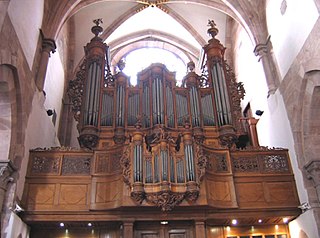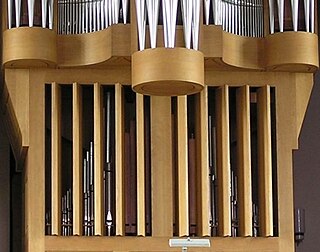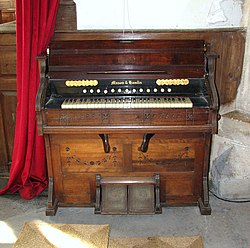
The pipe organ is a musical instrument that produces sound by driving pressurized air through the organ pipes selected from a keyboard. Because each pipe produces a single pitch, the pipes are provided in sets called ranks, each of which has a common timbre and volume throughout the keyboard compass. Most organs have many ranks of pipes of differing timbre, pitch, and volume that the player can employ singly or in combination through the use of controls called stops.

In music, the organ is a keyboard instrument of one or more pipe divisions or other means for producing tones, each played from its own manual, with the hands, or pedalboard, with the feet.

Rodgers Instruments Corporation is an American manufacturer of classical and church organs. Rodgers was incorporated May 1, 1958 in Beaverton, Oregon by founders, Rodgers W. Jenkins and Fred Tinker, employees of Tektronix, Inc., of Portland, Oregon, and members of a Tektronix team developing transistor-based oscillator circuits. Rodgers was the second manufacturer of solid state oscillator-based organs, completing their first instrument in 1958. Other Rodgers innovations in the electronic organ industry include solid-state organ amplifiers (1962), single-contact diode keying (1961), reed switch pedal keying for pedalboards (1961), programmable computer memory pistons (1966), and the first MIDI-supported church organs (1986).
Farfisa is a manufacturer of electronics based in Osimo, Italy, founded in 1946. The company manufactured a series of compact electronic organs in the 1960s and 1970s, including the Compact, FAST, Professional and VIP ranges, and later, a series of other keyboard instruments. They were used by a number of popular musicians including Sam the Sham, Pink Floyd, Sly Stone, Blondie, and the B-52s.

An electric organ, also known as electronic organ, is an electronic keyboard instrument which was derived from the harmonium, pipe organ and theatre organ. Originally designed to imitate their sound, or orchestral sounds, it has since developed into several types of instruments:

A pedalboard is a keyboard played with the feet that is usually used to produce the low-pitched bass line of a piece of music. A pedalboard has long, narrow lever-style keys laid out in the same semitone scalar pattern as a manual keyboard, with longer keys for C, D, E, F, G, A and B, and shorter, raised keys for C♯, D♯, F♯, G♯ and A♯. Training in pedal technique is part of standard organ pedagogy in church music and art music.

A manual is a musical keyboard designed to be played with the hands, on an instrument such as a pipe organ, harpsichord, clavichord, electronic organ, melodica, or synthesizer. The term "manual" is used with regard to any hand keyboard on these instruments to distinguish it from the pedalboard, which is a keyboard that the organist plays with their feet. It is proper to use "manual" rather than "keyboard", then, when referring to the hand keyboards on any instrument that has a pedalboard.

Bass pedals are an electronic musical instrument with a foot-operated pedal keyboard with a range of one or more octaves. The earliest bass pedals from the 1970s consisted of a pedalboard and analog synthesizer tone generation circuitry packaged together as a unit. The bass pedals are plugged into a bass amplifier or PA system so that their sound can be heard. Since the 1990s, bass pedals are usually MIDI controllers, which have to be connected to a MIDI-compatible computer, electronic synthesizer keyboard, or synth module to produce musical tones. Some 2010s-era bass pedals have both an onboard synth module and a MIDI output.
Keyboard expression is the ability of a keyboard musical instrument to change tone or other qualities of the sound in response to velocity, pressure or other variations in how the performer depresses the keys of the musical keyboard. Expression types include:

The pump organ is a type of free-reed organ that generates sound as air flows past a vibrating piece of thin metal in a frame. The piece of metal is called a reed. Specific types of pump organ include the reed organ, harmonium, and melodeon. The idea for the free reed was imported from China through Russia after 1750, and the first Western free-reed instrument was made in 1780 in Denmark.

In an organ, "Swell" refers to the division whose pipes are enclosed in a swell box. This box has a large opening covered with moveable shades or shutters which resemble heavy venetian blinds. When open, these shutters allow the pipes' sounds to travel freely from the box to the room. When closed, most of the sound is contained in the box. Thus the moveable shades provide a means of adjusting the loudness of the sound, and perhaps more importantly, of gradual crescendo ("swelling") and decrescendo.

Chord organ is a kind of home organ that has a single short keyboard and a set of chord buttons, enabling the musician to play a melody or lead with one hand and accompanying chords with the other, like the accordion with a set of chord buttons which was originated from a patent by Cyrill Demian in 1829, etc.

Piano pedals are foot-operated levers at the base of a piano that change the instrument's sound in various ways. Modern pianos usually have three pedals, from left to right, the soft pedal, the sostenuto pedal, and the sustaining pedal. Some pianos omit the sostenuto pedal, or have a middle pedal with a different purpose such as a muting function also known as silent piano.

A crescendo pedal is a large pedal commonly found on medium-sized and larger pipe organs, either partially or fully recessed within the organ console. The crescendo pedal incrementally activates stops as it is pressed forward and removes stops as it is depressed backward. The addition of stops, in order from quietest to loudest, creates the effect of a crescendo. The crescendo pedal is located directly above the pedalboard, to the right of any expression pedals that may be present. In actual use, the operation of the crescendo pedal usually does not move the draw knobs or stop tabs on the console; the stops are electronically activated inside the organ. Often an indicator light or lights will be present on the console to inform the organist of when the crescendo pedal is activated and how far it is engaged.

The pipe organ is played from an area called the console or keydesk, which holds the manuals (keyboards), pedals, and stop controls. In electric-action organs, the console is often movable. This allows for greater flexibility in placement of the console for various activities. Some very large organs, such as the van den Heuvel organ at the Church of St. Eustache in Paris, have more than one console, enabling the organ to be played from several locations depending on the nature of the performance.
RIHA Adagio is a Dutch electronic organ with a built-in Leslie speaker and a fine wood finish. Similar to other RIHA organs, the Adagio was made by Benelux Musical Instruments, The Hague, the Netherlands. A fine member of those line of all-transistor Dutch organs that featured eight models in three console finishes - walnut, teak, and rosewood. All of them have standard features, including, but not limited to, pedal volume control, brilliance control, and reverberation. The Adagio is one of the once popular RIHA models, along with the Festivo, the Andante, and the Allegro.

A residence organ is a musical organ installed in a personal home. Strictly speaking, the names residence and house organ are the most correct, the others being types of organs that can physically be used as residence organs, but that are not restricted to use solely in that context, and can also be used in, say, small churches, theatres, and so forth. A portative organ or a positive organ can be used in a residential setting, but the notion of a residence organ strictly embodies a permanence of place that is belied by the notion of portability embodied by the portatives and positives. Similarly, a chamber organ is in general a small organ for a room, but not necessarily for a room of someone's home.
The Brindley organ of St Mary's Church, Tickhill, South Yorkshire, England is a Victorian pipe organ influenced by the German organ building tradition.

Casavant Frères Ltée. Opus 1841 is a pipe organ built by the famous Casavant Frères of Saint-Hyacinthe, Quebec. The organ was first completed in 1911 as Casavant Brothers - Opus 452 for St. Andrew's Presbyterian Church at 40 Bentinck Street, Sydney, Nova Scotia, Canada. St. Andrew's later became St. Andrew's United Church and is now the Highland Arts Theatre.

A digital accordion is an electronic musical instrument that uses the control features of a traditional accordion to trigger a digital sound module that produces synthesized or digitally sampled accordion sounds or, in most instruments, a range of non-accordion sounds, such as orchestral instruments, pipe organ, piano, guitar, and so on. Digital accordions typically encode and transmit key presses and other input as Musical Instrument Digital Interface (MIDI) messages. Most digital accordions need to be plugged into a keyboard amplifier or PA system to hear their sounds.





















